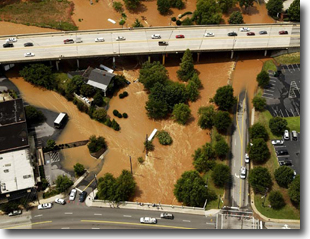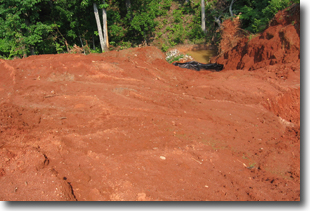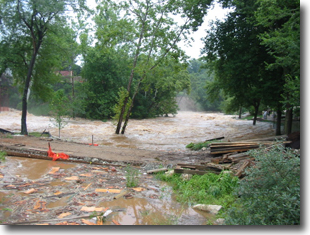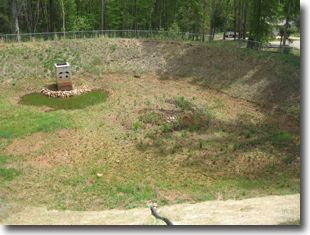What is Stormwater?
Stormwater Problems, Concerns and Priorities

Conversion, by people, of pervious surface soils to non-pervious man-made surfaces produces increased runoff volumes and flows.
This results in serious physical problems characterized by difficult and expensive solutions. The physical problems can ordinarily
be grouped in four categories: flooding, soil erosion, sedimentation, and pollution of lands and water bodies.
The easily recognized impacts produced by increased runoff include soil erosion; sedimentation; flooding of commercial and
industrial property, places of human habitation, streets, intersections, and highway underpasses; bridge and street washouts.
In addition to loss of human life and damage to real and personal property, the consequences of these impacts include health
hazards; delays of emergency vehicles and workers reaching places of employment; cleanup demands upon municipalities and citizens;
adverse effects upon the aesthetics of natural areas and urban environments; personal inconvenience; pollution threats to groundwater
supplies; disruption of ecological balances; disturbance of wildlife habitats; loss of animal life; and economic losses associated
with the problems identified above.
The basic goals of a stormwater management program in urban and metropolitan areas are similar - to solve existing runoff control
problems and prevent new problems from developing.
 Stormwater management encompasses three broad activity areas: (1) general administration, (2) regulation of land use and development,
and (3) physical intervention with stormwater to mitigate its impacts. In conducting such activities, stormwater management agencies
interact with various institutions, public and private. Five situations for such interaction are: (1) new land development, (2) improving
land drainage in developed areas, (3) regulating floodplains, (4) correcting the existing problems in floodplains, and (5) preventing
and correcting soil erosion, sedimentation, and water pollution problems.
Stormwater management encompasses three broad activity areas: (1) general administration, (2) regulation of land use and development,
and (3) physical intervention with stormwater to mitigate its impacts. In conducting such activities, stormwater management agencies
interact with various institutions, public and private. Five situations for such interaction are: (1) new land development, (2) improving
land drainage in developed areas, (3) regulating floodplains, (4) correcting the existing problems in floodplains, and (5) preventing
and correcting soil erosion, sedimentation, and water pollution problems.
Stormwater Management Philosophy
The basic principles underlying the goals and objectives for stormwater management include the following precepts:
The Drainage System is Part of a Larger Environmental System The drainage system can be managed simply as a support system
for an urban area or it can be managed in a way that will enhance efforts to achieve a broad range of goals and objectives.
Urbanization has the potential to increase both the volume and rate of stormwater runoff. The influence of planned new development
within a drainage basin should be analyzed and adjustments made to minimize the creation of flood problems.
Wetlands are Natural Storage Areas The wetland is nature's prescribed natural easement along a watercourse. The primary
natural function of each watercourse and its associated wetland and floodplain is the collection, storage and transmission of stormwater
runoff; it's function cannot be subordinated to any other use without applying costly compensatory control measures. Within these constraints,
wetland have the potential to help improve water and air quality, provide open space, preserve important ecosystems, and accommodate properly
planned urban network systems.
Stormwater Requires Space Stormwater management is a time-related space allocation problem. Water cannot be compressed, and if
natural floodwater storage is reduced by urban or other land use practices without appropriate compensatory measures, then additional space
will be claimed by the floodwaters at other locations.

Stormwaters Have Potential Uses Stormwater can be viewed as a resource out of place. In such a case, storage of stormwater is
the first step in a program to make use of the resource. These storage areas can be designed and operated to provide aesthetic amenities
and recreational space.
Water Pollution Control Measures are Essential Control of water quality is essential to full realization of the potential
benefits to be derived from watercourses and floodplains. Pollution control measures, which deal both with point and nonpoint discharges,
are an integral part of a drainage and flood control program. The 1977 Clean Water Act mandates identification of open space and recreation
opportunities that can be expected to result from improved water quality.
Preventive Measures Are Less Costly Use of preventive measures usually results in less cost to taxpayers than implementation of
corrective measures.
Purpose

One purpose of this Division is to protect, maintain, and enhance the environment of Greenville County and the short-term and long-term
public health, safety, and general welfare of the citizens of Greenville County by establishing requirements and procedures to control
the potential adverse effects of increased stormwater runoff associated with both future development and existing developed land. Proper
management of stormwater runoff will minimize damage to public and private property, insure a functional drainage system, reduce the effects
of development on land and stream channel erosion, attain and maintain water quality standards, enhance the local environment associated
with the drainage system, reduce local flooding, reduce pollutant loading to the maximum extent practicable and maintain to the extent
practicable the predeveloped runoff characteristics of the area, and facilitate economic development while mitigating associated pollutant,
flooding and drainage impacts.
Master Planning
Comprehensive drainage and flood control masterplanning is required to achieve the goals and objectives of an urban region. The community
wide planning process views flood control and drainage as subsystems of a larger and more important integrated urban system. Specific plans
are usually oriented only toward various portions of the drainage network, but they should always address important relationships to regional
land development and regional resources management.
Hazard Mitigation Plan
Greenville County is threatened by a number of natural hazards. These hazards endanger the health and safety of the population of the
community, jeopardize its economic vitality, and imperil the quality of its environment. Because of the importance of avoiding or minimizing
the vulnerabilities to these hazards, the public and private sector interests of Greenville County have joined together to create the
Greenville County Disaster Mitigation Committee to undertake a comprehensive planning process that has culminated into "The Greenville County
Hazard Mitigation Plan." Flooding was identified in Greenville County as the second biggest threat only behind ice storms. To read more about
floods in Greenville County, click here.
Goals and Objectives
The Disaster Mitigation Committee established eight (8) different goals during the planning process. These goals revolved mainly around
providing education to the public and government officials, improving communications and response activities and protecting structures.
Click here for Goals and Objectives
Completed Mitigation Initiatives
The implementation of the mitigation initiatives proposed as a result of the Disaster Mitigation Committee's planning process is an important
measure of the progress in implementation of the Greenville County Hazard Mitigation Plan. To read more about the Completed Mitigation
Initiatives, click here.
Proposed Mitigation Initiatives
This section of Greenville County Hazard Mitigation Plan contains the compilation
of the proposed mitigation initiatives that have been formulated as the result of the planning efforts by the Disaster Mitigation Committee.
For more information on the Proposed Mitigation Initiatives, click here.
Storm Water Ordinance
As a result of the NPDES program implementation processes, policies and procedures within the County were changed. In order to assist the
local design and construction community adapt to these changes a new storm water management ordinance was developed for the County.
Floodplain Ordinance
For the Greenville County Floodplain Ordinance and additional information on Floodplain Management,
click here.
Drainage Improvements
Drainage improvement projects are needed to mitigate neighborhood
flooding problems which impact yards, buildings, and roads. Drainage projects are funded through the Stormwater Utility. The projects are
identified by staff from several divisions, technical advisory groups and citizens. A list of several projects is approved by County Council
based on critical need and available funding. Designs are managed by the land development division and construction contracts are awarded
through competitive bidding and inspected by staff inspectors. At the present time, projects are generally limited to neighborhood drainage
systems and small off-line regional detention basins. Future projects involving creek channel improvements, floodproofing, and large on-line
regional detention projects may require additional funding sources.